Opened 1885-1918 Number of tracks 2-3 Electrification Railway electric traction | Character Elevated Owner New York City Stations 22 | |
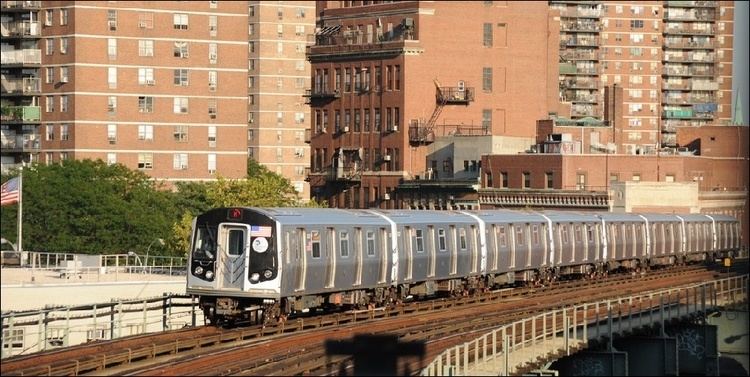 | ||
Track gauge 4 ft 8 ⁄2 in (1,435 mm) Terminis 121st Street, Marcy Avenue | ||
Bmt jamaica line r160a 1 j m trains at myrtle ave broadway am rush hour
The Jamaica Line (also known as the Broadway Line or Broadway (Brooklyn) Line) is an elevated rapid transit line of the B Division of the New York City Subway, in Brooklyn and Queens, New York City, United States. It runs from the Williamsburg Bridge southeast over Broadway to East New York, Brooklyn, and then east over Fulton Street and Jamaica Avenue to Jamaica, Queens. In western Jamaica, the line goes into a tunnel, becoming the lower level of the Archer Avenue Line in central Jamaica. The J and Z trains serve the entire length of the Jamaica Line, and the M serves the line west of Myrtle Avenue.
Contents
- Bmt jamaica line r160a 1 j m trains at myrtle ave broadway am rush hour
- Bmt jamaica line r32 r42 j trains at 121st st jamaica ave summer time
- Description
- History
- Eastern Jamaica Line third track proposals
- Service patterns
- Etymology
- References
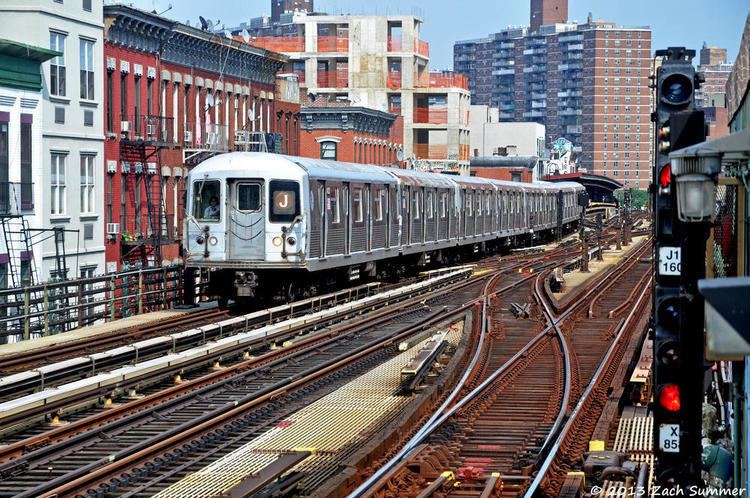
The longest elevated line in the system, the Jamaica Line includes the oldest existing elevated structure in the subway system - the original 1885 line of the Brooklyn Elevated Railroad, the BMT Lexington Avenue Line - between Gates Avenue and Van Siclen Avenue, as well as the newest elevated structure - the 1988 ramp into the underground Archer Avenue Line.

The Brooklyn–Manhattan Transit Corporation (BMT) originally operated the line with "westbound" trains heading toward Manhattan and "eastbound" trains heading toward Canarsie, Middle Village, or Jamaica, generally in agreement with compass direction. However, NYCT's railroad directions, which are north and south, replaced the BMT's west and east railroad directions, respectively. This reclassification resulted in services which ran through the BMT Nassau Street Line to Downtown Brooklyn having two south ends. To eliminate any confusion, the directions of train services in the eastern division were switched, with trains running towards Jamaica being considered Northbound. The KK (later K) and current M services were an exception to this, with Jamaica or Metropolitan Avenue remaining the south terminal, since they used the Chrystie Street Connection from the Jamaica Line to the IND Sixth Avenue Line.
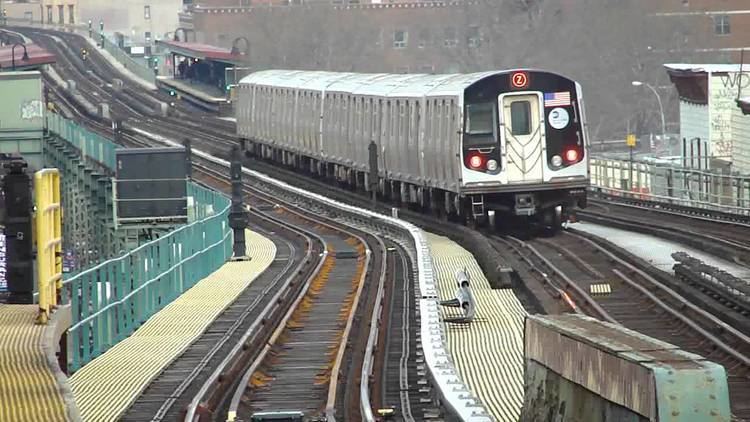
Bmt jamaica line r32 r42 j trains at 121st st jamaica ave summer time
Description
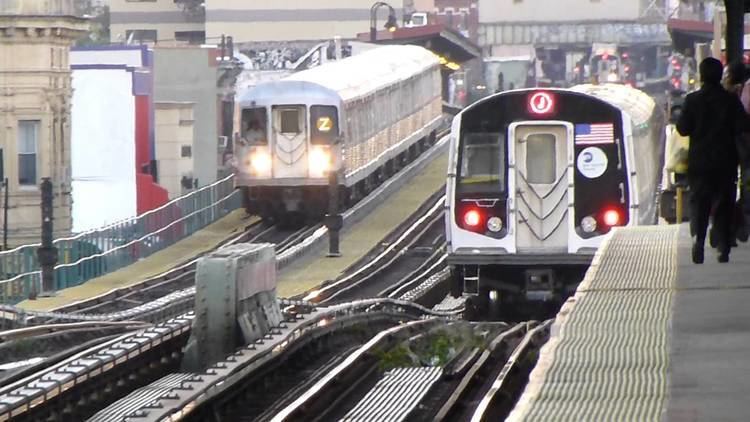
The Jamaica Line includes a variety of structures. The original BMT Jamaica Line started from Broadway Ferry, Brooklyn. The line was two tracks, and connected with Marcy Avenue, from the west. This section, which was called the "Broadway Spur", has a short, but easily seen remnant (about one-half of a block in length, no tracks, just maintenance buildings) west and south of where the line curves toward the Williamsburg Bridge.
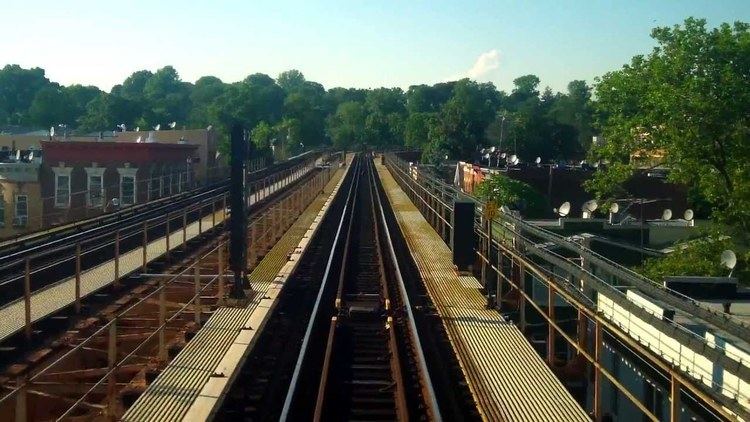
From Marcy Avenue to a point just before Alabama Avenue the line operates on the structure of old elevated railways, but substantially rebuilt and upgraded to a three-track line around World War I under the Dual Contracts of 1913. From Alabama Avenue to just before the current Cypress Hills station, the Jamaica Line operates on the oldest elevated structure in New York City, a steel-reinforced cast iron line opened in 1893. Interestingly enough, west of Alabama Avenue, a third middle trackway exists and elevates over the other two tracks, ending just west of the Alabama Avenue station. This track was intended to be an express track, but engineering studies completed after the work started indicated that the vibration of trains passing over the stations would be too severe and would literally shake the stations apart.

Between Crescent Street station and Cypress Hills, the line runs on an "S-curve", turning north from Fulton Street onto Crescent Street, then east onto Jamaica Avenue. The curves are at nearly 90-degree angles, forcing trains to drastically reduce speed to 15 miles per hour in order to traverse them. The line east of Cypress Hills is known as the Jamaica Avenue Line, the newest section of the line which was built under the Dual Contracts. This structure has provisions on its entire length for three tracks, but a center track was never built (see below), with the exception of a layup track at 111th Street and another between 160th Street and 168th Street on the now-demolished original end of the line.
Four curves on the line, including the two on the Jamaica Avenue "S-curve", rank among the 30 sharpest curves in the subway system.
History
The Union Elevated Railroad, leased to the Brooklyn Elevated Railroad, opened an elevated line above Broadway from Gates Avenue northwest to Driggs Avenue in Williamsburg on June 25, 1888. This was a branch of the existing Lexington Avenue Elevated, which then ended at Van Siclen Avenue; Broadway trains ran between Driggs and Van Siclen Avenues. A popular free transfer was available at Gates Avenue to Lexington Avenue trains towards Downtown Brooklyn. The Broadway Elevated was extended to Broadway Ferry on July 14, 1888.
An extension of the Broadway Elevated east to Cypress Hills, over Fulton Street and Crescent Street, opened on May 30, 1893, and the company extended both Lexington Avenue and Broadway trains to the new terminal. This extension incorporated portions of the recently demolished Park Avenue Elevated. A connection to the Williamsburg Bridge was established in 1908, rendering the two westernmost stations on the Broadway Ferry Branch obsolete by July 3, 1916. The eastern extension along Jamaica Avenue to 168th Street was opened on July 3, 1918.
Joint service with the Long Island Rail Road's Atlantic Branch existed between Norwood Avenue and Crescent Street stations with a connection built at Chestnut Street in Brooklyn. This allowed BRT trains to access the Rockaways and Manhattan Beach, while affording the LIRR a connection into Manhattan to the BRT terminal located at Park Row over the Brooklyn Bridge (this service predated the opening of the East River Tunnels to Penn Station). Nevertheless, the Interstate Commerce Commission ended this service in 1916 when they classified different operating standards between rapid transit trains and regular heavy rail railroads such as the LIRR.
By the time the Independent Subway System extended the Queens Boulevard Line along Hillside Avenue in Jamaica in 1937, residents became dissatisfied with the Jamaica El. In the mid-1960s, after the 1940 consolidation of the BMT with the IRT and IND, the Metropolitan Transportation Authority Archer Avenue Subway began in 1973. However, the city was hit by a major financial crisis during the mid-1970s delaying the completion and opening of the new line. Regardless of these circumstances, the three easternmost stations (Sutphin Boulevard, 160th Street, and 168th Street) were closed on September 10, 1977, with most of that segment of the line being demolished in 1985. The two others west of that point (Metropolitan Avenue and Queens Boulevard) were closed in 1985, with the line there being demolished in 1990 despite opposition to the closure of that segment of the line by some area residents. The Archer Avenue subway was opened in 1988. Two remnants of the former Jamaica El in Jamaica itself still exist today; the 144th Street Powerhouse, which is now used for the Archer Avenue Subway, and the station house and tower for 168th Street, which can be found on the southeast corner of Hillside Avenue and 165th Street and is now used as a women's clothing store.
Eastern Jamaica Line third track proposals
On July 7, 1934, the Transit Commission ordered that the BMT construct a transformer in Woodhaven at 77th Street, which would provide more power, and therefore it would allow the construction of a third track on the Jamaica El.
In 1958, the New York City Transit Authority first proposed the installation of a third track on the Jamaica El to provide peak-direction express service. The 1958 plan would have eliminated two tight right-angle curves of the Crescent Street "S-curve" between the Jamaica Avenue and Fulton Street portions of the route, by building a new elevated structure that would run diagonally from 80th Street to about Grant or Nichols Avenues, just east of Crescent Street. A 50- to 75-foot-wide right-of-way would have been needed, and since the line would have cut diagonally across several streets, 75 homes were slated to be torn down. Since the new elevated structure would take a more direct route, some local stations would be eliminated. The stops at Cypress Hills and Elderts Lane would have been eliminated, and a new stop replacing them would have been built around 75th Street and either Rockaway Boulevard or 91st Avenue. As part of the 1959 capital budget of the Transit Authority, $25,250,000 was allocated for the construction of a third track on the Jamaica Elevated from 160th Street to Alabama Avenue. The stations from Alabama Avenue to and including Crescent Street are: Alabama Avenue, Van Siclen Avenue, Cleveland Street, Norwood Avenue and Crescent Street. All of these stations have center island platforms; to allow for the construction of a third track, the current platforms would be demolished and replaced with side platforms. The Alabama Avenue and Van Siclen Avenue stops would be replaced by one stop in between the two stations to allow for better spacing, one-half a mile, between stations. The Cleveland Street station would have been replaced with a station farther to the west of the existing station, and the same would have been done with Crescent Street. The Norwood Avenue station would not have been replaced.
A suggested alternative that would not have required the demolition of homes would have been to have the elevated structure between Eastern Parkway and Cypress Hills replaced, with a new structure that would run directly via Jamaica Avenue with new stops built.
On October 9, 1958, because of a lack of funds and because of community opposition, the City Planning Commission removed the project from the capital outlay budget. On July 14, 1959, the third-track project was put into the New York City Transit Authority's 1960 budget. On August 18, 1959, the New York City Transit Authority through an appeal made by the Authority's chairman, Patterson, tried to obtain approval from the City Planning Commission for a $27 million project to construct a third track on the BMT Jamaica Line. The installation of the third track would have attracted passengers from the overcrowded IND Queens Boulevard Line, as there would be significant time savings between 168th Street and Marcy Avenue. The Planning Commission killed the plan in the prior year, because of insufficient evidence that there was a need for such a project.
On June 18, 1959, skip-stop service was implemented on the Jamaica El, with trains stopping at alternate stations between 168th Street and Eastern Parkway with the hope of enticing riders from the IND Queens Boulevard Line to use the new skip-stop service. If skip-stop service was a success, the Transit Authority would have shelved the triple-tracking project.
The project, as it was planned in 1962, would have necessitated the condemnation of about 200 homes and would have cost $35 million. The only express stop between 168th Street and Eastern Parkway would have been Woodhaven Boulevard, which would have needed to be reconstructed to allow for express platforms to be built. The project had serious community opposition, with the district leader of the 13th Assembly District, Arthur A. Gray, saying that the project was "an unnecessary and unwarranted renovation of an antiquated elevated structure in which the transportation needs of our community are sacrificed for the convenience of the many Nassau residents who board the line at its Jamaica terminus." The project was thought as becoming worthless in a few years, as Jamaica was planned to become a big shopping center, and therefore, the el would have had to come down. Suggestions were made to raze the elevated in this section to allow for a shopping mall in Woodhaven. The City Planning Commission continued to oppose the project on the grounds of the "inadequacies of the project".
The NYCTA once again requested for funds for the third-tracking of the Jamaica Line for its 1965–1966 fiscal year. This time the projected cost would have been reduced to $16,450,000. In November 1967, William Ronan, chairman of the Metropolitan Commuter Transportation Authority, and later the chairman of the Metropolitan Transportation Authority, suggested that money from a transportation bond issue could have paid for the installment of the third track on the line.
Service patterns
The line has had two major service patterns: the 14 Broadway (Brooklyn) Line (earlier called the Canarsie Line, before that line was connected to the 14th Street Line) and the 15 Jamaica Line. Eventually, the 14 became the KK (which became the K in 1974) and the 15 the J; the K was eliminated in 1976. The Z was introduced in 1988 to provide skip-stop service with the J, using the same pattern that the 14/K and 15/J formerly used in multiple instances throughout their history.
Etymology
From its accession by the BRT to and beyond city ownership in 1940, the portion of the line from its western terminus to Cypress Hills was known as the Broadway El or the Broadway-Brooklyn Line, to distinguish from the underground Broadway-Manhattan Line. Beyond that point it was known as the Jamaica Avenue El or the Jamaica Line. Subsequent to city takeover, the dividing line between the Broadway and Jamaica Avenue Lines was often considered to be the more westerly station at Eastern Parkway, now known as Broadway Junction.
Since the discontinuance of separate Broadway-Brooklyn services, the entire line is now known as the Jamaica Line.
